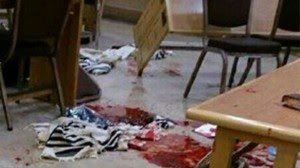The following by Timothy R. Furnish is reposted here with the permission of the
Middle East Forum:
by Timothy R. Furnish
Middle East Quarterly
Spring 2005, pp. 51-57
Images of masked terrorists standing behind Western hostages in Iraq and Saudi Arabia have become all too common on Arabic satellite stations such as Al-Jazeera and Al-Manar. Islamist websites such as
Muntadiyat al-Mahdi[1] go further, streaming video of their murder.
The February 2002 decapitation of
Wall Street Journal reporter Daniel Pearl, true to its intention, horrified the Western audience. Chechen rebels, egged on by Islamist benefactors, had adopted the practice four years earlier,[2] but the absence of widely broadcast videos limited the psychological impact of hostage decapitation. The Pearl murder and video catalyzed the resurgence of this historical Islamic practice. In Iraq, terrorists filmed the beheadings of Americans Nicholas Berg, Jack Hensley, and Eugene Armstrong. Other victims include Turks, an Egyptian, a Korean, Bulgarians, a British businessman, and a Nepalese. Scores of Iraqis, both Kurds and Arabs, have also fallen victim to Islamist terrorists' knives. The new fad in terrorist brutality has extended to Saudi Arabia where Islamist terrorists murdered American businessman Paul Johnson, whose head was later discovered in a freezer in an Al-Qaeda hideout. A variation upon this theme would be the practice of Islamists slitting the throats of those opponents they label infidels. This is what happened to Dutch filmmaker Theo Van Gogh, first gunned down and then mutilated on an Amsterdam street,[3] and to an Egyptian Coptic family in New Jersey after the father had angered Islamists with Internet chat room criticisms of Islam.[4]
 |
Daniel Pearl, pictured in an image sent to media organizations by
his kidnappers. Credit: Daily Mail. Photo not from original article. |

